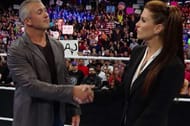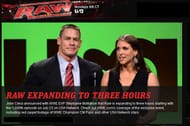Unless you’ve been living under a rock, you’ve probably heard about the imminent return of the WWE Brand Split. The Brand Split was a concept introduced way back in 2002, which saw RAW and SmackDown! each assigned their own authority figure (General Manager), with separate rosters, storylines and title matches.
At one point, RAW and SmackDown! even had their own individual PPV offerings.
During the Brand Split’s infancy, it was truly an exciting concept. It became a major deal to see a RAW Superstar show up on SmackDown! or vice versa. Such an occurance either meant a major, cross-brand match up, or that a Superstar was breaking the rules to get at a rival who performed on the opposing show. Unfortunately, as the years went by, the concept very quietly crumbled away, until it was a concept in name only.
WWE has no plans for these former AEW wrestlers? Here's why!
Despite the fact that WWE never officially did away with brand separation, in recent years, things have reverted back to the way they were in the Pre-Draft days, with RAW acting as the flagship show where the storylines get developed and SmackDown! being reduced to the B-show (also now loaded with incessant amounts of RAW replay footage).
But things have changed quite a bit in recent months. The Brand Split is returning in earnest and now is as good a time as ever to try it, with WWE NXT rapidly releasing some of the greatest talent in the world onto the WWE main roster.
#1 2nd time is the charm
As previously mentioned, this will be the WWE’s second attempt at a brand split. In 2002, the company initiated its first attempt, dividing RAW and SmackDown! into two separate, unique entities with dedicated rosters, creative teams and storylines, with little week to week interaction outside of cross brand storylines involving titles or General Managers.
Initially, this approach worked well.
After being cost the Undisputed WWE Championship at Backlash vs Hulk Hogan, thanks to interference from SmackDown!’s Undertaker, RAW’s Triple H made an unannounced appearance on his rival’s show, beating him all the way to the backstage area and ultimately being (kayfabe) arrested and fined for the assault and for appearing on a show he was not contractually allowed to appear on.
It was a big deal.
This would continue for nine years, with both shows running through numerous General Manager characters and, for the majority of the time period, operating with brand exclusive PPVs and only sharing the Big 4 (SummerSlam, Survivor Series, The Royal Rumble and WrestleMania).
Over time, the concept would be continually watered down, with brand exclusive PPVs and championships falling by the wayside and “cross-brand” storylines becoming exceedingly common.
By 2011, the concept was all but officially dissolved, with storylines and Superstars regularly appearing on both programs and, with the audience already acclimated to it, WWE quietly did away with the brand split on an official basis.
Though the concept started with a bang, it ended with the tones of the world’s tiniest violin trailing off into silence.
This time around, the WWE has a unique opportunity to do it right, but for that to happen, several things need to change.
#2 Cut RAW’s running time and make it less boring
Okay, it’s been said a bunch of times, but RAW has long since worn out the welcome of the 3-hour format. If WWE has proven anything over the last several years, it’s that it has no idea how to fill a 3-hour program 52 times a year.
In their current state, they can barely pull that off with PPV outings, so doing it every single Monday for RAW is simply unfeasible.
The program, in its current state, drags like an anchor through an ocean of clay. It’s filled with recaps of events that are barely 20 minutes old, backstage filler segments and repetitive matches.
The RAW creative team is also clearly burned out, and RAW’s storylines often feel phoned in and basic. How many times have Dean Ambrose and Chris Jericho wrestled each other in the last month?
As if WWE needed another distraction, much of RAW these days is also spent trying to tiptoe around the booking of WWE World Heavyweight Champion Roman Reigns, who is quite possibly the least popular main event star on the roster, but is being booked as a white bread babyface.
As a result, WWE typically opts to either forgo giving him a match on RAW or not having him Main Event when he does wrestle, as a way of avoiding those bad reactions.
To sum up, RAW desperately needs to return to a more consumable 2 hour format, with less BS and more relevant content. WWE needs to employ the KISS method: Keep It Simple, Stupid.
#3 Make SmackDown! important
WWE is already moving in the right direction when it comes to doing right by SmackDown!. The neglected “B-Show” is getting a major upgrade with the implementing of the 2nd Brand Split by way of (finally) switching from a taped format to live TV.
By making this switch, it appears WWE is finally ready to make SmackDown! destination programming again. As a personal example, I haven’t watched SmackDown! more than twice in three years and at no point have I had any difficulty following storylines or making sense of what’s going on. That’s because SmackDown! has basically been RAW: The Abridged Version, for years now.
With SmackDown! going live, and rumors swirling that WWE may be bringing back brand exclusive PPVs, it’s time for SmackDown! to be taken seriously again. This time around, there shouldn’t be anything to label SmackDown! as the “B-show”.
Getting drafted to SmackDown!, for example, shouldn’t be looked at as a demotion.
#4 New era, new stars: Enter NXT
With the whole “New Era” thing that WWE is trying to push, and with both main roster shows apparently gearing up for a renewed focus, now is the time for WWE to earnestly call up some NXT prospects to round out the rosters. The guard has already been subtly changing over the past few years.
Shows that used to be carried by John Cena, Randy Orton, Sheamus and Alberto Del Rio are being carried by Seth Rollins, Dean Ambrose, Kevin Owens and Sami Zayn, just to name a few.
NXT has not only become WWE’s own way of embracing the indy circuit, it has also allowed the company to dramatically shift its focus as it pertains to the type of talent hired.
Several years ago, the WWE was all about hiring football players, body builders, models and other types of athletes and giving them a crash course in “Sports-Entertainment” and hoping for the best.
The wild rise of NXT has changed the company’s attitude, leading to WWE picking up such wrestling diamonds as Samoa Joe, AJ Styles, Bobby Roode, Hideo Itami and Finn Balor. For this to succeed, it’s time for WWE to commit to the future and allow the stars of tomorrow to lead the charge into this “New Era”.
How WWE has messed up John Cena's last run - Check here!





